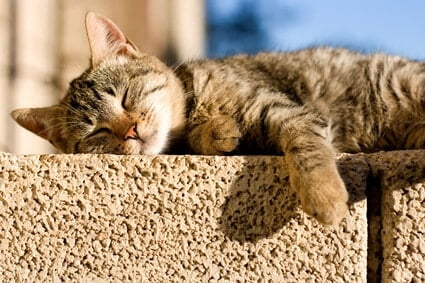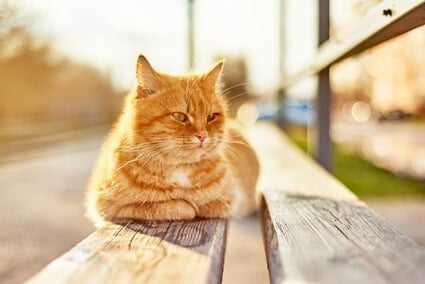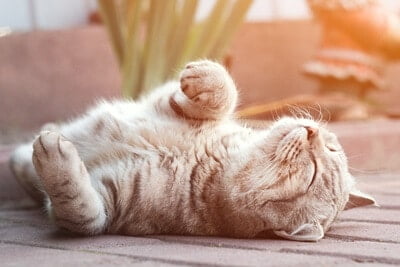Cats are sun worshippers. Indoor cats will station themselves at a window, basking in any rays that may enter. Outdoors cats will often spend hours sunbathing and napping, showing reluctance to come inside.
Cats are descended from desert-dwelling animals, so living in the sunshine is their natural state. In addition, ambient warmth makes sleeping more comfortable for felines. A cat’s body temperature drops while it dozes, and lying in the sun tempers this. Cats spend up to 15 hours a day asleep, so sunlight is important to staying comfortable.
Many cats will spend all day in the sun if afforded the opportunity. This temptation must be managed carefully. Cats can be burned by the rays of the sun and develop heatstroke or skin cancer.
Why Do Cats Like Sunbathing?
Cats and sunshine are among the most natural pairings in the world. If a glimmer of sunlight can be found, it’s a cat likely will track it down. Once this has occurred, most cats will sunbathe for prolonged periods.
There are exceptions to this rule. Some breeds, including the Norwegian Forest Cat, Maine Coon, Persian and Siberian, thrive in cooler conditions. Most felines prefer a warmer temperature, though. This is based on the ancestry of domesticated cats.
Housecats evolved from wild felines that lived in the Middle Eastern desert some 100,000 years ago. This means that most cats retain a preference to warm temperatures. Just as a Florida native would struggle in Alaska, cats are happiest in a hot climate. Genetically, it’s what they are accustomed to.
In addition, the sun encourages sleep for cats. Partly, this is down to simple relaxation. As discussed, cats feel most comfortable in a warm climate. This means that, if treated to direct sunlight, a cat will become increasingly tranquil. Dozing is the next step to this.
More importantly, the warmth of the sun counters any drops in temperature. As explained by Science, the body temperature of a cat drops while it sleeps. By napping in the sun, the cat will not grow too cool and wake up in discomfort.
Older cats may also seek the sun to ease general discomfort. Arthritis becomes likely in any cat older than 10. Cool temperatures will magnify these aches and pains in the bones and joints. By staying in the sun, the cat is likelier to remain comfortable.

Why Do Cats Roll in the Sun?
The main reason for a cat rolling over in the sun is to expose its belly. The cat will enjoy the feeling of the sun, but fur blocks much of the heat. By rolling over, the sun hits the cat’s bare belly. This is a fast-track to warmth and enhanced body temperature.
The cat will also be protecting other body parts. The ears, for example, will feel the heat of the sun. The nose, too. This can cause the nose leather to dry out, which is comfortable. By changing position, the cat is shielding its ears and nose from UV rays.
It’s also possible that your cat is simply expressing a moment of pure contentment. Cats often roll over to express happiness. A cat may roll over upon greeting an owner, for example. As cats enjoy basking in the sun, this could be a demonstration of pleasure.
Whatever the reason, keep an eye on your cat. If it rolls over onto its back, gently try to turn it over after a while. If the cat falls asleep, it places its health at risk with excessive sun exposure.
Is The Sun Good for Cats?
Sun is important for cats in appropriate doses. Cats are infinitely happier when warm and dry. This makes the summer a favored time of year for all felines. Cats find it much easier to relax when the sun is shining.
If your cat enjoys basking in the sunshine, allow it to do so. Just take appropriate safety precautions. Ensure that your cat has a shady area to retreat to if necessary. There are definite advantages to allowing a cat to sunbathe, though.
Energy
It is a misconception that cats draw energy from the sun. Sunshine will not automatically make a cat more vibrant than cooler climates. Sunshine does prevent a cat from losing energy, though. This makes sunlight a great way for a cat to relax and recuperate after a busy day.
Cats burn a great many calories while going about their daily business. While it may look like your cat spends all day sleeping, this is not through laziness. It is a necessity. Hunting, play and general movement are all exhausting to a cat, especially once it grows older.
In addition to this, cats need to burn calories to stay warm. This is why cats are typically hungrier during the winter. By basking in the rays of the sun, the cat stays toasty. This, in turn, means it burns less energy.
Of course, this leads to additional advantages for cats. If your cat is warm, it will not want to eat as much. This can only be positive for a cat’s weight. This is especially important in senior cats, who exercise less than younger felines.
While your cat doesn’t gain energy from lazing in the sun, it also doesn’t lose any. This can make a big difference to a cat’s comfort and quality of life. By taking advantage of the sunshine, your cat can focus its physical efforts on what matters most.
Vitamin D
One of the great advantages of sunshine is the Vitamin D that it provides. As explained by the Feline Journal of Medicine and Surgery, cat skin does not absorb Vitamin D. Access is blocked by fur. Instead, Vitamin D must be sourced from food.
This does not mean that your cat will not benefit from the sun’s rays, though. Vitamin D becomes trapped in the cat’s fur. When the cat invariably grooms itself, it ingests the vitamin orally. This is not as effective as direct skin absorption, but it’s better than nothing.
This can be important for senior cats. PLOS One explains how higher levels of Vitamin D boost feline survival following sickness. Vitamin D will not single-handedly stave off sickness, but it improves immunity in times of danger.
As with all things related to the sun, moderation is key. Excessive Vitamin D can lead to toxicity. Rat poison, for example, is effective due to high doses of this component. If your cat is eating a balanced diet, limit time in the sun.
Hormone Cycles
Cat hormones are governed by sunlight and the natural environment. This is especially important in unspayed females. A cat’s heat cycle will often revolve around the seasons.
Most cats enter heat at the onset of spring and conclude an annual cycle in the fall. Cats do not have access to a calendar. They use the sun to assess a time of year. If the sun is shining, a cat’s body produces less melatonin. This hormone suppresses the heat cycle.
This is a matter of survival for cats. Feral or stray cats do not wish to birth litters of kittens in the winter. It will be increasingly difficult to keep them warm and safe. Ergo, with little sunshine, the cat does not enter heat.
If you want your female cat to breed, she must spend time in the sun. This will activate her hormones accordingly, and her body will do the rest. If you keep a cat indoors, away from natural light, her hormone cycle will fall out of sync with the seasons.
Even if your cat is fixed, it still needs the sun to regulate hormones. Sunshine tells a cat when it is time to grow or shed fur.
Longer, sunnier days inform the cat that summer is coming. As a result, the cat starts to shed. This is particularly important for long-haired breeds. Without this natural reaction to sunlight, these cats can grow uncomfortable in the sun.
Can Cats Get Sunburn?
Cats can be burnt if they spent too much time in the sun. This is just as painful for a cat as it is for a human. It will lead to skin blistering and peeling. Your cat will also be reluctant to groom or to be petted. Its skin will be sensitive.
All cat breeds can be sunburned, though some are at greater risk than others. Longhaired cats are less likely to experience sunburn. Their thick fur prevents UV rays from reaching the skin as freely. This protection will only last so long though. Sunburn can still occur.
White cats are most are risk of sunburn. Hairless cats, or those with thin fur, are also at heightened risk. Without a coat of fur to protect the skin, UV rays will meet no resistance.
Cats can be protected against sunburn by applying sunscreen. Focus on hairless parts of the cat’s body, such as the belly, nose, ears, and lips.
There is a caveat here, though; most human sunscreens are dangerous to cats. Homosalate, Ethylhexyl salicylate, and xalicylate are commonly found in sunscreen and are all toxic to cats.
Check your local pet store for feline-friendly sunscreens. If you cannot find anything suitable, investigate sunscreens designed for human infants. These are typically unscented and chemical-free. Check suitability with a professional before applying, though.
If you are concerned about sunburn in your cat, practice prevention measures. Keep your cat out of the sun between 10 am and 3 pm when it’s hottest. Try to avoid letting your cat bask in sunlight through a window at these times, too.
Treating Sunburn in Cats
If your cat has sunburn, it will be in a lot of pain. Unfortunately, it may not be enough to deter further sunbathing. You must keep your cat indoors, closing any curtains or drapes until fully recovered.
Once your cat is out of direct sunlight, you can ease its discomfort. Start by filling a spray bottle with cool water and offer a gentle misting.
If your cat has particularly aggravated burns, apply a cool washcloth to the area. Hold this down for around five minutes, several times per day. This will ease some of the heat on the skin and minimize the risk of scratching. If a cat scratches dry skin, it may bleed.
Severe sunburn may need further treatment. Begin with conventional home remedies. Aloe vera and witch hazel will moisturize dry, burned skin. This will make your cat more comfortable. Apply these oils to a cotton pad and gently rub them on impacted skin.
Vitamin E supplements are also advisable. These could be ingested or rubbed straight into the skin – Vitamin E is safe for cats to consume. This will speed up healing and prevent any scars.
You will not need to see a vet unless your cat is significantly burned. In these cases, a painkiller may be required. In addition, your cat may risk infection if the skin is significantly damaged. Observe the cat for 24 hours, taking further action if needed.
Can Cats Get Sunstroke?
This is a form of heatstroke, which leads to hyperthermia. This is more serious than simple overheating. Hyperthermia can cause permanent, irreversible damage to a cat’s internal organs.
A cat is at risk of sunstroke if it basks in the high sun for several hours. This will steadily increase the cat’s body temperature above a safe level. Any temperature above 100 degrees Fahrenheit is dangerous. 104 degrees or above is an emergency. Signs that your cat is living with sunstroke include:
- Panting and drooling
- Restlessness
- Discolored gums and tongue – typically bright, deep red or dull gray
- Rapid heartbeat
- Lethargy
- Muscular weakness
- Mental confusion
- Loss of consciousness
Unfortunately, sunstroke can creep up on cats slowly. The cat may be dozing in the sun, unaware that it is steadily growing hotter. This is especially common in older cats. Senior felines fall into deep, restful sleep easier than their younger counterparts.
Alternatively, the cat may just not mind. In the moment, it is solely concerned with gaining as much sun as possible. Many cats will notice they are growing uncomfortable and seek shade, though.

Treating Sunstroke in Cats
If you think that your cat has sunstroke, encourage hydration immediately. If the cat will not drink water, offer Gatorade. The electrolytes in this drink will help. Alternatively, have frozen treats on hand. Meaty gravy frozen into ice cubes may be tempting.
Wrap the cat in a damp towel to reduce its body temperature. Do not place the cat in a tub of cold water. This will send its body into shock, causing further issues. The cat’s temperature needs to be lowered steadily, not drastically.
It is also advisable to make an appointment with a vet. If damage has been done to a cat’s internal organs, immediate treatment may be required. Vets can also provide your cat with an intravenous drip to improve hydration.
Can Cats Get Skin Cancer from The Sun?
The biggest danger to cats that enjoy sunbathing is skin cancer. Cats that spend excessive time in the sun risk basal cell carcinoma or squamous cell carcinoma.
Skin cancer is not a quick, overnight risk. Your cat will need to be sunburned multiple times for this to become a genuine risk. If your cat is sunburned, keep it away from UV rays for a prolonged period.
If you notice any lumps or bumps on your cat’s skin, have them investigated. There is every chance they are benign, but do not take chances. Even if the worst has happened, feline skin cancer has a promising prognosis when caught early.
Typically, the damaged skin will be surgically removed. If the cancer has not spread, this will be the end of your cat’s treatment. In aggressive cases, chemotherapy or radiotherapy may be needed. Remember though, this can all be avoided by managing your cat’s sun exposure.
Cats should always be permitted to enjoy the sun. Allow a feline to bask in the sun’s rays, and enjoy the benefits associated with this. Just be mindful of the risks involved. If you think your cat has had enough sun, bring it inside. It’s better to be safe than sorry.

